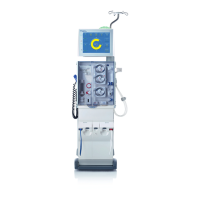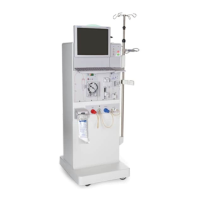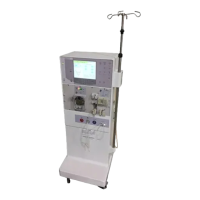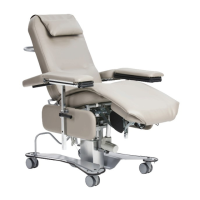Chapter 9: Calibration / adjustment
Fresenius Medical Care 4008 S (Version V10) SM-EN 7/01.13 9-55
9.3.1.4 Alternative: Adjustment without the set for air detector calibration
As an alternative, an adjustment is also possible using the set for air
detector calibration (see chapter 9.3.1.1 page 9-53).
Measuring equipment UMED, HMED or pressure gauge,
venous bubble catcher with syringe filled with degassed water or NaCl
solution (see venous bubble catcher in the AD page 9-52).
Measurement point Air Detector
Calibrating the air detector The device must be in the Service mode,
the jumper J1 / P.C.B. LP 450-2 must be set to the calibration position.
– Insert the venous bubble catcher into the air detector
(ultrasonic detector); for the moment, do not insert the line into the
venous occlusion clamp.
– Fill the venous bubble catcher. The fluid level must be set to
approx. 10 mm above the top edge of the sensor holder.
– Turn potentiometer 1 and potentiometer 2 on P.C.B. LP 450-2
clockwise, until the LED D5 and LED D10 on P.C.B. LP 450-2 are
dark.
Slowly (attention: time constant) turn potentiometer 1
counterclockwise, until LED D5 lights.
Slowly (attention: time constant) turn potentiometer 2
counterclockwise, until LED D10 lights (see figure LP 450-2).
– After completion of the calibration procedure, set the jumper J1 /
P.C.B. LP 450-2 back to the operation position.
Checking the air detector – Lower the fluid level in the venous bubble catcher:
An alarm must be emitted. LED D5 and LED D10 light.
If one or both LEDs are not illuminated, the calibration procedure
must be repeated.
– Raise the fluid level in the venous bubble catcher:
It must be possible to clear the alarm; both LEDs must be off.
– Remove the venous bubble catcher from the air detector.
– In addition, the venous occlusion clamp has to be checked and the
optical detector has to be calibrated and checked
(see chapter 9.3.1.2 page 9-54).
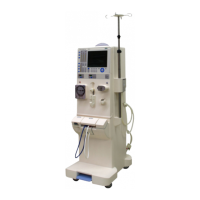
